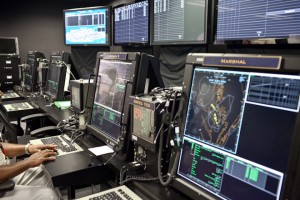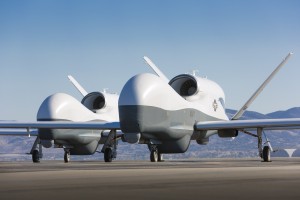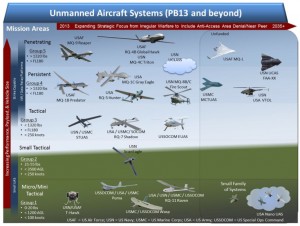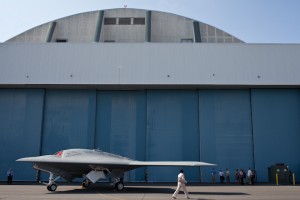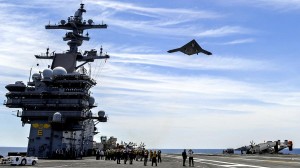See the intro to this series for a quasi-taxonomy of drones. This post would fall under the philosophical category mainly, with a hint of theoretical and practical.
The fallacy of the “man in the loop”
This concept is basically a sop to any concerns about the takeover of robots, and the autonomy of killing machines. It promises that a “man” (human) will always be there to “supervise” the use of lethal force by a “robot”. But one issue here is that the machine can handle things/decisions so much more rapidly, based on so much more information, that to involve a human would only slow things down, and possibly dilute the strength of that machine. What about “swarms” of many drones (a major practical/theoretical topic for future posts)? And the fact is, there are already a number of places where the use of force is not man-mediated.
Joshua Foust articulated this nicely last year.
The basic conceit behind a LAR is that it can outperform and outthink a human operator. “If a drone’s system is sophisticated enough, it could be less emotional, more selective and able to provide force in a way that achieves a tactical objective with the least harm,” said Purdue University Professor Samuel Liles. “A lethal autonomous robot can aim better, target better, select better, and in general be a better asset with the linked ISR [intelligence, surveillance, and reconnaissance] packages it can run.”
This proposal for a drone fighter would almost explicitly remove that man from the loop by design.
“In Byrnes’ conception, machines have the edge in making the lightning-fast decisions necessary to win a close-quarters aerial battle. “Humans average 200 to 300 milliseconds to react to simple stimuli, but machines can select or synthesize and execute maneuvers, making millions of corrections in that same quarter of a second,” he writes.
And
“With FQ-X, autonomy for the conduct of the engagement would return to the air vehicle to take advantage of its superior processing speed and reaction times,” Byrnes proposes.
There’s much more here on the Byrnes proposal for lethal autonomy.
In their unmanned systems roadmap for 2013 (out to 2038, mind you), DoD itself debunks the fallacy, going so far as to use scare quotes:
Take the “man” out of unmanned. Currently personnel costs are the greatest single
cost in DoD, and unmanned systems must strive to reduce the number of personnel required to operate and maintain the systems. Great strides in autonomy, teaming, multi-platform control, tipping, and cueing have reduced the number of personnel required, but much more work needs to occur.
Shane Harris on same in an essay titled, in fact, “Out of the Loop”. I’m especially fond of this quote:
Listening to Prosek, one hears that gradual shift towards the inevitable. “When I was a kid and you got onto an elevator, there was a guy sitting on the stool who asked you what floor to go to,” he says. “Now most people are not aware there ever was an elevator operator out there.”
The Economist works to cement the death of the concept with an exhortation to “drop the pilot”. Now, the article isn’t about autonomy, but in summarizing the feelings of Pakistani quasi-targets they aren’t thinking of a “pilot” sitting in an air-conditioned trailer in Nevada.
And, one of those “pilots” or “men in the loop” speaks.
I was going to link to a GAO report no one would read, but this is an article meant to be read, after all:
The idea behind UCLASS — of which the X-47B is merely the demonstration model — involves doing away with the joysticks and computer banks that most remote operators use to control their drones. Instead, Northrop’s proprietary software lets drone pilots program where they want the drone to fly. Then they can go get a sandwich. “It’s smart enough for you to put really interesting contingencies” in the X-47B’s way, says Capt. Jaime Engdahl, the Navy’s program manager for its flying drones. “It has the smarts to react to that condition.”
How about “drone on drone” dogfights? A guy sitting in a trailer in Nevada, with all the latency that entails, is going to have problems insinuating himself into that loop.
“We pilots are the decision makers … and the claim to fame of fighter pilots are dogfights. So in the future, part of the process of replacing jet fighters with UAVs will be the ability to start dogfights between drones,” he added.
We’ll get more into the issue of practice and “loitering” time in a future post, but in advance, consider a missile sans drone that can loiter (i.e., not be “shot” directly onto a target, but rather, sit in the air for hours or days before landing) like a drone.

